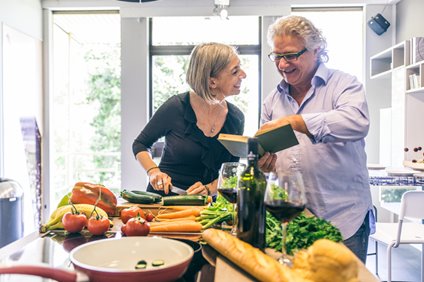DIY Tips: Eating Healthy Starts at Home
When it comes to eating healthy, there may be a grain of truth in the old adage, “If you want something done right, you have to do it yourself.” If you’re daunted by dining at home, Registered Dietitian April Ho shares tips to help make meal prep easy and fun.
Food author Michael Pollan suggests that you can eat healthy and even lose weight eating whatever you want, as long as you prepare it from scratch and eat it at home. This works for two main reasons:
- Home-cooking means you’ll be using healthy ingredients and, in turn, making a healthier meal.
- If you prepare the meal yourself you’ll appreciate it more; you’ll take your time eating to enjoy it, which is a healthier way to eat.
Many people have trouble getting motivated to cook at home. If this sounds familiar, here are four tips to help you get started:
- Make sure your kitchen is a place you want to be. Cook in a place you are naturally excited to be in. Nobody wants to be in messy, cluttered, dark environment. Clean it out, add some plants to make the space more inviting, and make it a well-lit area.
- Find a good source of recipes that make your mouth water. Before touching a pot or pan, collect recipes and get excited about something you can make. You can use Pinterest or other recipe sources such as AllRecipes.com and different blogs – there’s any endless supply online. And don’t forget about cookbooks!
- Split up your prep time from your actual cooking time. Separating these tasks makes both parts easier. There’s less stress when you are preparing because you don’t have to worry about following a recipe yet. Then when you start cooking, if your prep is already done, the actual cooking is easier because you don’t have to worry about all of the initial steps. You can just focus on putting things together to create the dish.
- Start cooking by making a simple vegetable side dish. If you start with a main dish or entrée the stakes are higher. You want it to turn out well because you won’t have anything to eat if something goes wrong. A side dish isn’t the main part of the meal, so you can rely on other entrées or side dishes to complete the meal if a new recipe you are experimenting with doesn’t work. Plus, by making a vegetable side, you’re adding extra vegetables to meal. That means you’ve added more fiber and improved the overall heart health quality of the meal.
Use these tips to get inspired to cook at home, have some fun, and try new, healthy recipes.

April Ho is a registered dietitian and certified personal trainer with the Center for Community Health & Prevention at URMC. You may occasionally find her at the Rochester Public Market doing nutrition and cooking demonstrations as part of Foodlink, Inc.’s Just Say Yes to Fruits and Vegetables program.

